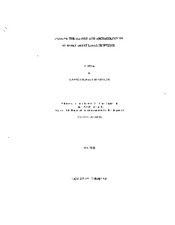| dc.creator | Robinson, David Stewart | |
| dc.date.accessioned | 2012-06-07T22:57:24Z | |
| dc.date.available | 2012-06-07T22:57:24Z | |
| dc.date.created | 1999 | |
| dc.date.issued | 1999 | |
| dc.identifier.uri | https://hdl.handle.net/1969.1/ETD-TAMU-1999-THESIS-R6345 | |
| dc.description | Due to the character of the original source materials and the nature of batch digitization, quality control issues may be present in this document. Please report any quality issues you encounter to digital@library.tamu.edu, referencing the URI of the item. | en |
| dc.description | Includes bibliographical references (leaves 285-294). | en |
| dc.description | Issued also on microfiche from Lange Micrographics. | en |
| dc.description.abstract | The early Great Lakes propeller Indiana was built as a combination passenger- and freight- carrying steam vessel in 1848 at Vermilion, Ohio by itinerant Lake Erie shipbuilder Joseph M. Keating. Over the span of its ten-year career, the vessel served the interests of its owners and several different shipping and railroad lines transporting passengers and a wide variety of cargoes before sinking on the evening of 6 June 1858 with a load of iron-ore ''down-bound'' for Cleveland. Indiana holds an important place in the history of steamboat technology as the best-preserved extant example of an early propeller-driven Great Lakes vessel. Built seven years after the first propeller-schooners appeared on the lakes, at a time when scientific principals were being applied for the first time in ship design and screw propulsion was proving itself to be an efficient, reliable, and economical mode of transporting freight, Indiana represents a ''second generation'' of early Great Lakes propellers that were larger, faster, and better equipped than their predecessors to serve the burgeoning Great Lakes freight and passenger trades of the late 1840s and the 1850s. Although virtually undocumented elsewhere, the transition between the transient propeller-schooner of the early 1840s and the standardized propeller liner of the middle 1850s is clearly evident in Indiana's archaeological remains. This thesis presents the results of a multi-year archival and archaeological study of Indiana's operational history and wreck site. Narrative descriptions of Vermilion, Indiana's builder and owners, its ports of call, routes travelled, sinking, and salvage are provided in the introductory chapters (Chapters I and II). Chapter III presents an account of the archival and archaeological research that was conducted in the preparation of this thesis and includes a description of Indiana's wreck site. The main body of this thesis (Chapter IV) contains a detailed description of Indiana's hull construction, propulsion machinery, and deck equipment. Chapter V provides the supplementary evidence necessary for reconstructing Indiana's hull form and construction. Conclusions are presented in Chapter VI. Appendices include materials analyses reports and an extensive list and tabulation of Indiana's cargoes. | en |
| dc.format.medium | electronic | en |
| dc.format.mimetype | application/pdf | |
| dc.language.iso | en_US | |
| dc.publisher | Texas A&M University | |
| dc.rights | This thesis was part of a retrospective digitization project authorized by the Texas A&M University Libraries in 2008. Copyright remains vested with the author(s). It is the user's responsibility to secure permission from the copyright holder(s) for re-use of the work beyond the provision of Fair Use. | en |
| dc.subject | anthropology. | en |
| dc.subject | Major anthropology. | en |
| dc.title | Indiana: the history and archaeology of an early Great Lakes propeller | en |
| dc.type | Thesis | en |
| thesis.degree.discipline | anthropology | en |
| thesis.degree.name | M.A. | en |
| thesis.degree.level | Masters | en |
| dc.type.genre | thesis | en |
| dc.type.material | text | en |
| dc.format.digitalOrigin | reformatted digital | en |


